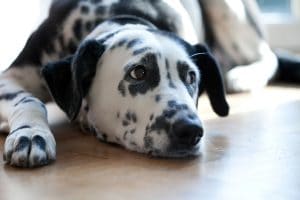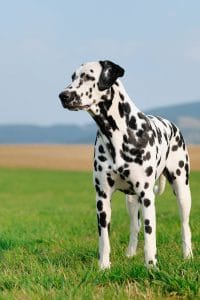
History
The origin of the Dalmatian is a matter of mystery and dispute. The World Canine Organization recognises that it originated in Dalmatia, a region in Croatia, but does not give the country patronage rights to the breed. Similarly spotted dogs have appeared in documents as old as ancient Egypt and as varied as Italy and Africa.
In its modern avatar, the breed can be traced back to 18th century England, where it served as a coach dog for horse-drawn carriages due to its affinity for horses and ability to keep up with and protect them. Thanks to their capacity and stamina, Dalmatians have served many roles from retrievers to ratters to trail hounds. In England and in the USA, Dalmatians are well known as firehouse mascots, a function dating back to the period when fire carts were drawn by horses.
Physical Attributes
Dalmatians are medium to large in size, weighing between 16 and 32 kilograms, standing around 48 to 61 centimetres tall, with males being slightly larger than females. They are muscular, strong and athletic-looking, with a deep chest and a long, tapering tail. They have round, dark eyes and dropped ears. Their pure white coat with black or liver-coloured spots is their most recognisable feature. Other colours appear in the breed but are not accepted for show dogs, among whom distinct and evenly distributed markings are prized. Although their coat is short and fine-haired, Dalmatians shed a little all year round and a lot during fall and spring.

Health and Care
Dalmatians are relatively easy to groom and should be brushed frequently. They have a great deal of stamina and require vigorous daily exercise which should include a good run. Brisk jogging alongside a bicycle is good exercise, and is important to keep the breed from developing destructive behaviours.
Dalmatians are active and agile and perform well in canine activities like flyball and as volunteer therapy dogs. They are intelligent and enthusiastic, but can also be independent and wary of strangers, so socialization and early training are important to keep them occupied and motivated. Their enthusiasm can be too much for small children, but they are wonderful playmates for older children.
Ten to 12 percent of Dalmatians are born deaf and approximately 22 percent are deaf in one ear. The breeds susceptibility to deafness was not spotted by early breeders so the breed became renowned for being unintelligent when in fact the opposite is true. This is now recognised as a problem in Dalmatians but unfortunately continues to be a frequent problem. Dalmatians are also prone to urinary stones and skin allergies. Their average lifespan is 11 to 14 years.



it was awesome!!!!!!
My “Big Joe” 5 years old dalmatian is always sweet to me and tough to some guys. Last 2 years ago I called my bf to take care my dog for a week coz I have to attend a conference. I honestly misses more to my Big joe dog than to my boyfriend. After a week of being apart to my lovely dog, he got sick and won’t eat and scratching most of the time. I bring him to vet and diagnosed of having Demodectic mange. I was so angry to my boyfriend and broke up with him for not taking care my dog. He was treated by PetsBestRx Demodectic Mange Treatment – Kennel Combo of Q-based Solutions, just a few days later , the scratching was gone. After this was happened I never had a boyfriend again. And I am so much happy that I have my Big Joe in my side.